The Millennium Villages project based at the Earth Institute at Columbia University certainly think they have cracked the problem of African poverty and hunger. The solution they suggest is a series of integrated, low cost packages which can be implemented together in a single village cluster setting, and then expanded on a massive scale. The proposed packages costing $75 per person/year involve a set of very familiar options, what the Economist recently dubbed ‘the magnificent seven’. These include, for example, agronomy interventions – notably seed and fertiliser inputs – combined with interventions in health (bed nets), nutrition (school feeding), hydrology (water harvesting and micro-irrigation), information technology (internet access) and so on in an integrated system aimed at tackling the complex problems of poverty and hunger identified in the MDG Hunger Task Force report ‘Halving Hunger: it can be done’.
It sounds great. And the prime advocate of the programme, Jeffrey Sachs, tells a convincing story; sufficiently convincing indeed to have raised approaching US$20m from generous philanthropists, foundations, corporations and governments (notably the Japanese), and encouraged the participation at the highest level of 10 countries across Africa in the pilot action research phase. Reviewing the available documentation on the project, however, much of all this seems very familiar. Who, for instance, remembers the experiments in integrated rural development from the 1970s? Who recalls the numerous NGO projects that pumped in resources only to see things falter once the project funding dried up? Is this just old wine in new bottles as some have claimed or something important and new?
Of the 12 initial Millennium villages, across different agro-ecological zones, several are located in the same countries where the Future Agricultures Consortium is working. In Ethiopia, Korano village in the Tigray was chosen, while in Kenya two villages were selected – one in western Kenya (Sauri), the site of past work by Millennium Villages project director Pedro Sanchez, and one in the pastoral north-east (Dertu). In Malawi a ‘hunger hotspot’ area near Zomba was chosen (Mwandama) where, according to the project website, “Earth Institute experts and local farmers worked around the clock in the fall of 2005 to distribute improved seeds and fertilizers to thousands of people in southern Malawi before the November rains came”.
These are all unquestionably poor communities, where the challenge of getting agriculture moving is key to reducing poverty and hunger. But is a concentrated effort focused on a very limited set of villages, with an emphasis largely on technical fixes really the solution? Is not the challenge of improving rural livelihoods in Africa more complex than this? What about institutional issues, politics and governance questions? And what plans are there for coordination of wider infrastructure and market linkages, especially if these cases – as the project advocates repeatedly state – are not to be yet another outside-funded island of success?
As the IDS Bulletin ‘New Directions for African Agriculture’ argued – focusing on the ‘fix’ at the micro-scale is not enough. This may bring important gains for a limited number of people for a limited period, but it is the sustained, long-term benefits of growth spurred by agriculture that is the target. As all the IFPRI studies of success in African agriculture show policies are key – and to get policies right this means attention to the complex arena of African politics. Taking a long-run view these studies showed too that success can be quite ephemeral. Boosts in maize production, for example, occurred in different parts of sub-Saharan Africa for periods when the combination of climate, economics and policy was right, but then the gains, often very suddenly, were lost. And this was not because of the absence of good seed and fertilizer – these have been available for maize at least since the 1950s.
Jeffrey Sachs argues strongly in a recent IRIN news service interview that: “There are no ‘magic bullets’, no single solution that will put an end to global poverty”. So far so good. But Sachs goes on to identify what he calls “quick wins” targeted on “hot spots” which if applied will go a long way to meeting hunger “targets”. The technocratic impulse is, it seems, not far away. Lessons from the past repeatedly suggest that apparently simple technocratic solutions – no matter how integrated, low-cost etc. – do not work in the longer term.
It is for this reason that the Future Agricultures Consortium focuses on the wider policy and institutional conditions for pro-poor agricultural growth, seeing the important priorities of investment – in infrastructure, equipment, skills and expertise – within this broader architecture. What is strikingly absent in the presentation at least of the Millennium Villages project is this wider institutional, political and policy context. Over the coming years, consortium partners in Ethiopia, Kenya and Malawi will be hoping to generate a local policy dialogue about future agricultures and appropriate policy solutions at national and local scales. Hopefully this will be a good opportunity to examine the experiences of the Millennium villages and help shape future strategies.
Links
Millennium Villages: Ian Scoones of Future Agricultures quoted in Nature
Ian Scoones and Robert Chambers quoted in Scientific American
ODI perspective on Millennium Villages.
Sources
Millennium Villages Project
MDG task force on hunger – ‘Halving hunger it can be done’ [Eldis Summary]
Video clip of talk by Jeffrey Sachs and some blog responses
Announcement of $10m of Japanese assistance
Economist – ‘The magnificent seven – how a few simple reforms can lift African villages out of poverty’ [27 April, 2006]
IRIN news report:‘No magic bullets to end poverty, says Jeffrey Sachs’ [22 March 2006]
IFPRI 2020 Focus: Building on Successes in African Agriculture
IDS bulletin/policy briefing: New Directions for African Agriculture

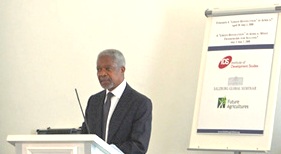 30 April – 2 May 2008 Toward a ‘Green Revolution’ in Africa?” is an Initiative of the
30 April – 2 May 2008 Toward a ‘Green Revolution’ in Africa?” is an Initiative of the 
 The Food, Agriculture and Natural Resources Policy Analysis Network (FANRPAN) announced today a three-year pilot project to help rural women farmers influence agricultural policy development in Southern Africa. Funding for the programme is provided by a $900,000 grant from the Bill & Melinda Gates Foundation.
The Food, Agriculture and Natural Resources Policy Analysis Network (FANRPAN) announced today a three-year pilot project to help rural women farmers influence agricultural policy development in Southern Africa. Funding for the programme is provided by a $900,000 grant from the Bill & Melinda Gates Foundation.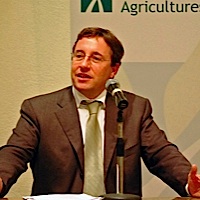
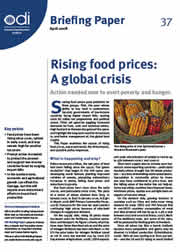 Soaring food prices pose problems for three groups. First, the poor whose ability to buy food is undermined. Second, governments of low-income countries facing higher import bills, soaring costs for safety net programmes and political unrest.
Soaring food prices pose problems for three groups. First, the poor whose ability to buy food is undermined. Second, governments of low-income countries facing higher import bills, soaring costs for safety net programmes and political unrest.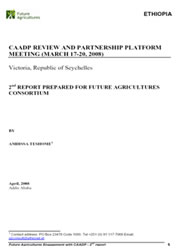 The Comprehensive Africa Agriculture Development Programme (CAADP) is an AUC/NEPAD initiative designed to encourage investment in key areas (pillars) that can make the earliest difference to Africa’s agricultural crises. CAADP was adopted by the Head of States as a framework for the revival of agriculture and officially launched in 2003 at a meeting held in Midrand, South Africa.
The Comprehensive Africa Agriculture Development Programme (CAADP) is an AUC/NEPAD initiative designed to encourage investment in key areas (pillars) that can make the earliest difference to Africa’s agricultural crises. CAADP was adopted by the Head of States as a framework for the revival of agriculture and officially launched in 2003 at a meeting held in Midrand, South Africa.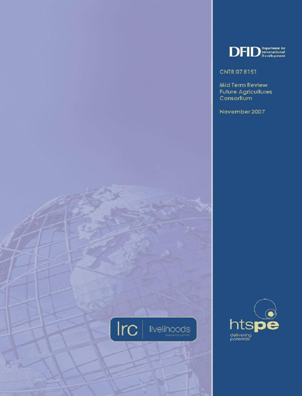 (RNRA) Team of DFID’s Policy Division. It is a project that has the aim to improve the quality of public policy towards agriculture in low income Sub- Saharan Africa (SSA) countries. This objective arises from DFID’s Policy Paper onagriculture published in 2005 (DFID, 2005), in which the central importance of agricultural growth for poverty reduction in countries where the majority of the poor live in rural areas is affirmed. The project began in May 2005 and is scheduled to complete its current phase in March 2008. The project team has submitted a proposal to DFID for a second phase of the project to last from April 2008 to March 2011. The tasks of this mid-term review are asfollows (see Review TOR at Annex A):
(RNRA) Team of DFID’s Policy Division. It is a project that has the aim to improve the quality of public policy towards agriculture in low income Sub- Saharan Africa (SSA) countries. This objective arises from DFID’s Policy Paper onagriculture published in 2005 (DFID, 2005), in which the central importance of agricultural growth for poverty reduction in countries where the majority of the poor live in rural areas is affirmed. The project began in May 2005 and is scheduled to complete its current phase in March 2008. The project team has submitted a proposal to DFID for a second phase of the project to last from April 2008 to March 2011. The tasks of this mid-term review are asfollows (see Review TOR at Annex A):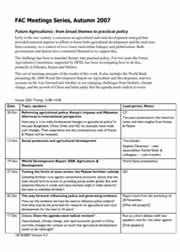 Early in the new century a consensus on agricultural and rural development emerged that provided renewed impetus to efforts to boost both agricultural development and the rural non-farm economy, in a context of ever closer rural-urban linkages and globalisation.
Early in the new century a consensus on agricultural and rural development emerged that provided renewed impetus to efforts to boost both agricultural development and the rural non-farm economy, in a context of ever closer rural-urban linkages and globalisation.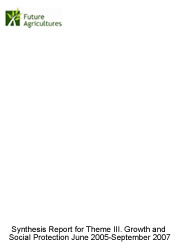 This report describes the main activities and outputs of the Future Agriculture Consortium(FAC) under the theme of Growth and Social Protection for Phase I. Core work on the theme has involved the development of a conceptual framework setting out potential and evolving synergies and conflicts between social protection and agricultural growth in the livelihoods of poor and vulnerable people, in local and national economies, and in policy formulation and implementation.
This report describes the main activities and outputs of the Future Agriculture Consortium(FAC) under the theme of Growth and Social Protection for Phase I. Core work on the theme has involved the development of a conceptual framework setting out potential and evolving synergies and conflicts between social protection and agricultural growth in the livelihoods of poor and vulnerable people, in local and national economies, and in policy formulation and implementation.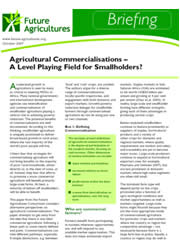 Accelerated growth in agriculture is seen by many as critical to meeting MDGs in Africa. Many national governments and international development agencies see intensification and commercialisation of smallholder agriculture playing a central role in achieving poverty reduction. The potential bene.ts of commercialisation are well documented.
Accelerated growth in agriculture is seen by many as critical to meeting MDGs in Africa. Many national governments and international development agencies see intensification and commercialisation of smallholder agriculture playing a central role in achieving poverty reduction. The potential bene.ts of commercialisation are well documented.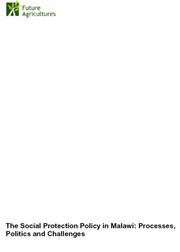 This paper is based on a study undertaken to critically understand the dynamics of policy-making and processes under the auspices of the Future Agricultures Consortiums. (FAC) sub-theme on politics and policy processes hosted by the Institute of Development Studies (IDS) in the United Kingdom. FAC.s operative philosophy is that contrary to the traditional and highly stylized perspective, policy making does not happen in neat distinct stages except perhaps in the minimal sense that policies are proposed, legislated and implemented.
This paper is based on a study undertaken to critically understand the dynamics of policy-making and processes under the auspices of the Future Agricultures Consortiums. (FAC) sub-theme on politics and policy processes hosted by the Institute of Development Studies (IDS) in the United Kingdom. FAC.s operative philosophy is that contrary to the traditional and highly stylized perspective, policy making does not happen in neat distinct stages except perhaps in the minimal sense that policies are proposed, legislated and implemented.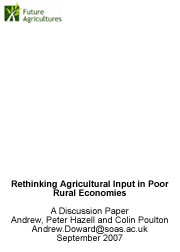 As part of discussions on the future of pastoral production systems in East Africa there have been a number of recent interventions arguing that something urgently needs to be done to deal with a Malthusian style crisis in pastoral areas. In short, the argument goes, there are too many people which, combined with a declining (or not increasing) productivity of the natural resource base, means that not enough livestock can be kept to sustain a viable pastoral system.
As part of discussions on the future of pastoral production systems in East Africa there have been a number of recent interventions arguing that something urgently needs to be done to deal with a Malthusian style crisis in pastoral areas. In short, the argument goes, there are too many people which, combined with a declining (or not increasing) productivity of the natural resource base, means that not enough livestock can be kept to sustain a viable pastoral system.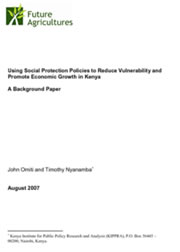 By John Omiti and Timothy Nyanamba
By John Omiti and Timothy Nyanamba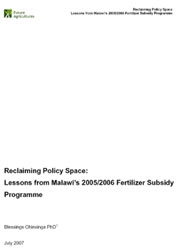 This paper is based on research work carried out the under auspices of the Politics and Policy Processes theme of the Future Agricultures Consortium (FAC). It demonstrates that political context matters in agricultural development policy issues, using as illustration the case of the fertilizer subsidy programme (FSP) launched in Malawi in the 2005/2006 growing season.
This paper is based on research work carried out the under auspices of the Politics and Policy Processes theme of the Future Agricultures Consortium (FAC). It demonstrates that political context matters in agricultural development policy issues, using as illustration the case of the fertilizer subsidy programme (FSP) launched in Malawi in the 2005/2006 growing season.